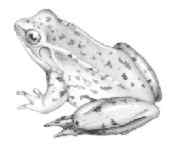

You’ll always know when you’ve run across the mountain yellow-legged frog (Rana muscosa) because they smell like garlic. These frogs live near streams at 7,000 feet around the Lake Tahoe area, but they are becoming quite scarce. Scientists theorize it has something to do with Eastern brook trout (Salvelinus fontinalis), although they’re not quite sure what is happening. The trout have been planted in streams for many years, but their populations have grown so large that scientists believe they’re simply running out of food in streams. Scientists finally realized that the fish are regenerating naturally and that the plantings were overpopulating streams. As the habitat for the trout declines, the populations of frogs have disappeared in many streams. This is true on the Eastern Sierra as well as the Tahoe area. Scientists do not know if the trout are eating the frogs or if the decline of trout habitat is also affecting the frog population. Some scientists believe the two populations are unrelated. The federal government has cut back the planting of fingerlings and study continues on the dwindling frog population.
The mountain yellow-legged frog was once the most common amphibian in the high
elevation portions of the Sierra Nevada, where it inhabited the many fishless
lakes, ponds, streams, and marshes. Today, this frog is one of the rarest amphibians
in the Sierra Nevada, and because of the severity of its decline is likely to
soon be listed as endangered under the federal Endangered Species Act. Although
the cause of this decline is currently the subject of intensive study, the introduction
of non-native trout into the thousands of naturally fishless lakes in the Sierra
Nevada is well-known to be a major factor. Contaminants drifting out of the
Central Valley and disease may also play significant roles. Researchers have
recently begun investigating the feasibility of reversing the mountain yellow-legged
frog's decline by removing non-native trout from lakes. These efforts have led
to dramatic increases in frog populations, and suggest that fish removal efforts
conducted throughout the Sierra Nevada could bring the mountain yellow-legged
frog back from the brink of extinction.
Read and add comments about this page